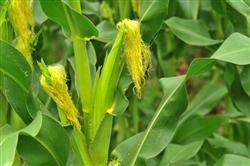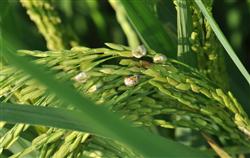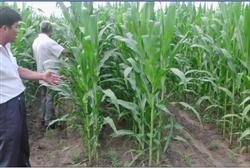Corn planting technology: what should be paid attention to in the middle and later period of summer corn?

What should be paid attention to in the middle and later period of summer corn? Please give the introduction of summer corn in the middle and later period to pay attention to the following points for reference: fertilization (1) ear fertilizer. Generally, nitrogen fertilizer is re-applied in the big trumpet mouth period, accounting for about 50% of the total topdressing amount, and standard nitrogen fertilizer is applied 30-40 kg per mu. (2) grain fertilizer. It generally accounts for about 10% of the total amount of topdressing, with 10 kg of ammonium bicarbonate per mu. When fertilizing, open a ditch 10-15 cm wide at 10 cm from the plant, with a depth of 9-12 cm. Cover the soil and water strictly after fertilizing in the ditch. Corn borer can be controlled at panicle stage with 3% phoxim granule 1.5-2 kg plus fine sand 5-6 kg per mu, or 0.1% poisonous soil mixed with 50% phoxim EC and scattered evenly in corn heart leaves. Control corn leaf spot, spray with 50% carbendazim 500-800 times liquid; control corn rust and brown spot, spray 75-100 ml per mu with 20% triadimefon EC at the initial stage of the disease. Emasculating corn will help to increase production. Male removal can reduce nutrient consumption, promote female ear development, reduce plant height, improve ventilation and light transmission conditions, enhance lodging resistance, overcome the disjoint phenomenon of female and male ear flowering, help to meet at flowering stage, increase seed setting rate, and reduce the harm of borer. To get rid of the male, it is necessary to grasp the time, it is difficult to operate early, and the male ear is too tender, so it is easy to pull out or bring out the heart leaves; if it is too late, the nutrient consumption is too much and the yield increase is not significant. The appropriate time for castration is when the male ear pulls out about 1/3 to half of the heart leaves, and then the hand can be pinched and pulled out with a little effort. It is better to operate from 9 am to 4 pm on a sunny day, so that the wound can heal easily. The number of castrated plants generally accounts for about 1/3 of the total number of plants in the whole field, with no more than half at most. The two lines near the ground and the two plants on the ground should not be emasculated, so as not to affect pollination. After castration, the effect of auxiliary pollination is better. Click to get more corn planting techniques click to get more food crop planting techniques
- Prev

Rice diseases and insect pests: what are the rice diseases and insect pests in August?
What are the diseases and insect pests of rice in August? Please introduce and guide how to control rice diseases and insect pests in August. The key control objects are rice false smut, panicle neck blast and bacterial leaf spot, as well as rice planthopper and rice leaf roller. Can refer to the following methods for prevention and control: 1, a week before the rice break (when packing a big bag),.
- Next

Corn planting technology: how to manage summer corn in the middle and later stage?
How to manage summer corn in the middle and later stage? Please introduce some good management methods for summer corn in the middle and later stage: first, drought-resistant and waterlogging-resistant corn enters the vegetative growth and reproductive growth stage after jointing, which is the key period of large ear, and it is also drought, waterlogging, wind, hail and other disastrous weather.
Related
- The first cup of black tea in spring, the flavor and history of tea gardens in Kenya, Africa
- The computer can not only choose potatoes, but also grow tea rice. AI will grow winter oolong tea champion.
- It is not only the inflated tea bitten by insects, but also engraved with the four seasons tea in Beipu.
- The Oriental Beauty Tea Festival in Zhuxian County takes the stage at the weekend to experience the plus-size feast of oil tea.
- & quot; Oriental Beauty Tea & Exploration of Emei in Hsinchu, the hometown of quot;
- The new variety of strawberry "Tainong 1" dessert is the first choice with mellow aroma. Crimson gorgeous
- History of Tea in Taiwan: from Wild Inner Mountain to Export Tea Garden
- Two types of Taiwan Oriental Beauty Black Tea won the British three-Star Award for Childhood Tea Xiang Zhang Jiaqi changed from pilot to champion tea maker.
- Banana species and varieties: the planting history of Taiwan Xianren banana and dwarf banana is long, is banana disease resistant?
- Coffee planting Technology: Qianjie Coffee from Seedling to harvesting

